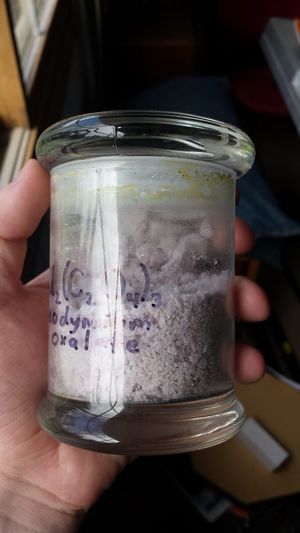Neodymium oxalate
 |
This article is a stub. Please help Sciencemadness Wiki by expanding it, adding pictures, and improving existing text.
|

| |
| Names | |
|---|---|
| IUPAC name
Neodymium ethanedioate
| |
| Other names
Neodymium ethanedioate(2:3)
Neodymium(III) oxalate | |
| Properties | |
| Nd2(C2O4)3 | |
| Molar mass | 552.538 g/mol |
| Appearance | Lavander solid |
| Odor | Odorless |
| Melting point | 40–50 °C (104–122 °F; 313–323 K) (hydrate, decomposes) |
| Boiling point | Decomposes |
| Slightly | |
| Solubility | Insoluble in organic solvents |
| Hazards | |
| Safety data sheet | Sigma-Aldrich (hydrate) |
| Flash point | Non-flammable |
| Except where otherwise noted, data are given for materials in their standard state (at 25 °C [77 °F], 100 kPa). | |
| Infobox references | |
Neodymium oxalate or neodymium(III) oxalate is the chemical compound with the formula Nd2(C2O4)3. At standard temperature and pressure, it is a lavender-colored solid. It is most commonly encountered in the process of purifying neodymium from magnets.
Contents
[hide]Properties
Chemical
Neodymium oxalate is inert to most strong acids, including but not limited to concentrated hydrochloric, sulfuric, and nitric acids. In order to turn this into a usable neodymium compound, it must first be calcined to neodymium(III) oxide.
Physical
Neodymium oxalate is a pink solid under natural light, and may acquire a yellow tinge under incandescent light.
Preparation
Neodymium oxalate may be prepared from an acid-dissolved neodymium magnet by the addition of copious amounts of oxalic acid (available as wood bleach) and hydrogen peroxide (the more concentrated the better). At first, the precipitate will be either yellow or green, as iron oxalate coprecipitates. Upon addition of the hydrogen peroxide, however, the solution should fizz slightly, and in short order the yellow or green color of the precipitate should leach away. The iron is chelated into a vivid, emerald green complex in solution, and the neodymium oxalate remains insoluble as a pink or white precipitate.
Projects
Handling
Safety
Neodymium is a heavy metal, and as such is toxic if ingested. Standard gloves should be safe to handle neodymium compounds with. Oxalates and oxalic acid are toxic by ingestion, and may lead to kidney stones and other deleterious side effects. The effects are somewhat mitigated by the fact that neodymium oxalate is inert and water-insoluble, however.
Storage
Neodymium oxalate can be stored safely in any container.
Disposal
Neodymium oxalate should be converted into a less toxic form (such as the oxide, a refractory material) before being disposed of.